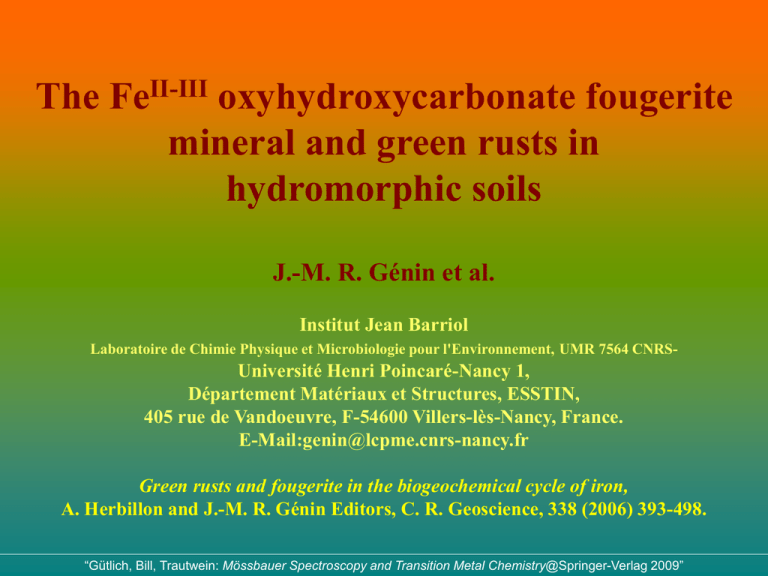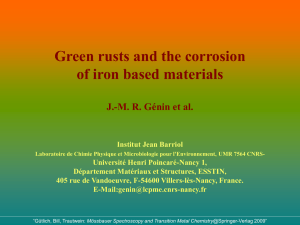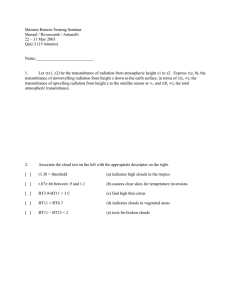Genin_Fougerite.ppt
advertisement

The FeII-III oxyhydroxycarbonate fougerite
mineral and green rusts in
hydromorphic soils
J.-M. R. Génin et al.
Institut Jean Barriol
Laboratoire de Chimie Physique et Microbiologie pour l'Environnement, UMR 7564 CNRS-
Université Henri Poincaré-Nancy 1,
Département Matériaux et Structures, ESSTIN,
405 rue de Vandoeuvre, F-54600 Villers-lès-Nancy, France.
E-Mail:genin@lcpme.cnrs-nancy.fr
Green rusts and fougerite in the biogeochemical cycle of iron,
A. Herbillon and J.-M. R. Génin Editors, C. R. Geoscience, 338 (2006) 393-498.
“Gütlich, Bill, Trautwein: Mössbauer Spectroscopy and Transition Metal Chemistry@Springer-Verlag 2009”
The morphology of hydromorphic gley soils, first described in 1905 by G. N. Vysostskii1, remained a mystery up till
recently when Mössbauer spectroscopy has been the determining tool to identify the iron containing compound
that lies in a horizon formed under waterlogged conditions in an anaerobic environment, which encourages
the reduction of iron compounds by microorganisms and often causes mottling of soil into a patchwork of
greenish-blue-grey and rust colors. This finding is of utmost practical importance since there exists a correlation
between the concentration of some pollutants and that of FeII ions that are dissolved in the water table. For
instance, nitrates disappear where FeII appear in the anaerobic zone by following the water level in equilibrium
with a mineral, which has been given the name of fougerite (IMA 2003-05). It occurs to be the FeII-III
oxyhydroxycarbonate of formula FeII6(1-x) FeIII6x O12 H2(7-3x) CO3 where the domain of x is limited to [0.330.67].
Originally studied for explaining the corrosion of iron-based materials, FeII-III hydroxysalts belong to the family of
layered double hydroxides (LDH) and are constituted of layers, [FeII(1-x) FeIIIx (OH)2 ] x+, and interlayers,
[(x/n)An-(mx/n)H2O]x-. Here, we shall consider only the case where the anion is CO32-.
1G.
N. Vysostskii, Gley, Pochvovedeniye, 4 (1905) 291-327.
Total Organic
Carbon (wt-%)
0
0
Depth (m)
•
0,
2
0,
4
CaCO3 (wt-%)
0
0
1
0
2
0
Exchangeable
Nitrate(mg kg-1)
-1
Fe
(mg
kg
)
0 N1
2
0
1
2
0
0
0
0
Exchangeable
Mn (mg kg-1)
Fe(II) of total Fe
2
00
1
1
1
1
1
2
2
2
2
2
(%)
4
0
6
0
0
2
4
Organic matter
Humus
6
0
2
Ferric oxyhydroxides
3
3
3
3
3
3
4
4
4
4
4
4
Vibeke Ernstsen, Geological Survey of Denmark and Greenland
fougerite
Depth profile analysis of a gleysol in Denmark through the redox zone between 2 and 3
meters deep. From left to right: Concentration of total organic carbon, calcium carbonate,
nitrate, exchangeable iron, {[FeII] / [Fetotal]} and exchangeable Mn. Nitrates disappear when
FeII appears.
Hydromorphic gley soil profile
Valley of the Vraine river, 10 km north of Vittel
(France)
D2
97
Transmittance %
Transmittance %
The FeII-III hydroxycarbonate can be prepared by coprecipitation of a mixture of ferrous and ferric
salts in the presence of carbonate ions when adding NaOH solution. Mössbauer spectra measured at
78 K demonstrate that the range of composition for x = [FeIII]/[Fetotal] is limited to [1/4, 1/3] since for
x > 1/3 there exists two phases , the Green rust at x = 1/3, GR(CO32-), and another phase, a-FeOOH.
The spectrum of GR(CO32-) consists of 2 ferrous doublets D1 and D2 with large quadrupole
splitting D and one ferric doublet D3 with small splitting.
x
0.25
x = 0.25
87
82
-4
D1
78 K
-3
-2
Transmittance %
101
99
97
x = 0.4
95
93
91
78 K
89
87
-12
D3
-8
(a)
-1 0
1 2
Velocity (mm s-1)
3
4
98
94
S2
S1
D3
D’1
(c)
-4
0
4
8
-1
Velocity (mm s )
12
-3
101
99
97
-1 0
1 2
Velocity (mm s-1)
3
4
S2
H
d 1.30
D 2.9
RA 52
D3
D’1
91
-12
(d)
x
-4
0
4
8
-1
Velocity (mm s )
FeII-FeIII ions coprecipitation giving for x > 1/3 a mixture of phases:
GR(CO32-) and goethite
0.4
D3 S1
490
0.50 0.43
0.47 0
25 17
S2
482
0.54
0
6
0.5
D3 S1 S2
12 H
473 453
d 1.29
0.49 0.39 0.53
D 2.87
0.48 0
0
RA 39
19 26 16
Hyperfine parameters
H (kOe), d and D (mm s-1), RA(%)
D1+D2
-8
26
0.33
D1 D2 D3
d 1.28 1.28 0.47
D 2.97 2.55 0.43
RA 48
18
34
D1+D2
x = 0.5
78 K
12
x
S1
95
93
(b)
-2
RA 62
D3
x
78 K
-4
D2
D3
D1
96
95
D1
d 1.28 1.28 0.47
D 2.97 2.55 0.43
D2
x = 0.33
97
Transmittance %
92
100
99
FeII(1-y)FeIIIy(OH)2 (y/2)CO3 with 1/4< y < 1/3
(a)
XRD and Mössbauer spectroscopy allowed us to
determine the structure of all FeII-III hydroxysalts
green rusts.
(b)
x = 0.33
FeII4 FeIII2 (OH)12 CO3
GR(CO32-) R(-3)m
With synchrotron
a = 0.317588(2) nm
c = 2.27123(3) nm
R. Aissa, M. Francois, C. Ruby, F. Fauth, G. Medjahdi, M. Abdelmoula, J.-M. Génin, Formation and crystallographical structure of hydroxysulphate and hydroxycarbonate
green rusts synthetised by coprecipitation • J. Phys. Chem. Solids, 67 (2006) 1016-1019.
Structure of GR(CO32-) FeII-III hydroxycarbonate at x = (1/3); (a) Three-dimensional view of the stacking of brucitelike layers. OH- ions lie at the apices of the octahedrons surrounding the Fe cations. CO32- ions in interlayers.
(b) Projections along the c axis of the CO32- anions for three interlayers constituting a repeat.
Génin, J.-M. R.; Aissa, R.; Géhin, A.; Abdelmoula, M.; Benali, O.; Ernstsen, V.; Ona-Nguema, G.; Upadhyay, C.; Ruby, C. Fougerite and FeII-III hydroxicarbonate green
rust; ordering, deprotonation and/or cation substitution; structure of hydrotalcite-like compounds and mythic ferrosic hydroxide Fe(OH)(2+x). Solid State Sci., 7 (2005) 545572.
The in situ oxidation of green rusts by deprotonation
Use a strong oxidant such as H2O2, Dry the green rust and oxide in the air,
Violent air oxidation, Oxide in a basic medium…
0.1
d
b
0.0
-0.1
a
-0.2
0.2
0.4
0.6
0.8
1.0
1.2
{2 × [n(H2O2) / n(Fetotal)] + (1/3)}
96
95
78 K
94
-4
-3
-2
-1 0 1 2
Velocity (mm s-1)
x = 0.33
Transmittance %
92
x ~ 0.63
88
84
-4
(c)
78 K
-3
-2
-1 0 1 2
Velocity (mm s-1)
D4
x ~ 0.63
31 %
D3
3
D1
28 %
(c)
32 %
D2
9%
78 K
-1
0
1
2
100
3
Quadrupole splitting D (mm s-1)
(a)
0
4
D1
D2
17 %
1
2
Quadrupole splitting D (mm s-1)
x ~ 0.78
92
88
-4
(d)
78 K
-3
-2
-1 0 1 2 3
Velocity (mm s-1)
x ~ 0.78
D3
D4
4
(d)
43 %
D1 + D2
35 %
22 %
78 K
-1
0
1
2
3
Quadrupole splitting D (mm s-1)
88
x ~ 0.50
(b)
78 K
-3
-2
-1 0 1 2 3
Velocity (mm s-1)
D3
38 %
D4
16.5 %
78 K
4
D1
(b)
33 %
x ~ 0.50
3
96
84
4
D3
78 K
3
92
84
-4
50 %
33 %
1.4
Probability density (p)
Transmittance %
Probability density (p)
96
D3
(a)
-1
100
Transmittance %
c
x = 0.33
D1
Probability density (p)
0.2
97
D2
12.5 %
-1
0
1
2
3
Quadrupole splitting D (mm s-1)
Transmittance %
e
100
98
x=1
96
(e)
78 K
94
Probability density (p)
Transmittance %
0.3
Probability density (p)
Eh(V)
FeII-III oxyhydroxycarbonate FeII6(1-x) FeIII6x O12 H2(7-3x) CO3
100
100
0<x<1
99
96
H
with
H2O2
2 O2
D2
98
-4
-2
0
2
Velocity (mm s-1)
4
D4
x=1
67 %
(e)
D3
33 %
78 K
-1
0
1
2
Quadrupole splitting D (mm s-1)
“Gütlich, Bill, Trautwein: Mössbauer Spectroscopy and Transition Metal Chemistry@Springer-Verlag 2009”
3
GR(CO32-)
x = 0.33
(a)
H2O2
x = 0.50
(b)
0.2 µm
(a)
(c)
10
20
30
Diffraction Angle (2q°)
Intensity (arb. unit)
110 113
012
018
015
006
Intensity (arb. unit)
003
0.2 µm
Aerial
x=1
(d)
(d)
20
30
Diffraction Angle (2q°)
FeII-III
TEM and XRD patterns of the
due to the in situ deprotonation
0.5 µm
(b)
10
40
H2O2
x=1
(c)
40
oxyhydroxycarbonate
0.5 µm
The oxidation or reduction of GR(CO32-) gives rise to GR(CO32-)* or GR(CO32-)§,
i.e. FeII6(1-x) FeIII6x O12 H2(7-3x) CO3 where x [0, 1]; the fougerite mineral is limited to
the range [1/3, 2/3].
R = {nOH- / (nFe(II) + nFe(III))}
Ferroxyhite d’ FeOOH
fougerite
3
Pro- & deprotonation of
GR(CO32-)
2.5
G Fe(OH)2
E
Fe3 O4
D
GR(CO32-)*
Ferric GR
B
2
GR(CO32-)
Stoichiometric
A
1.67
1.5
Voltammograms obtained on an iron
disc at 10 mVs−1 in 0.4 M NaHCO3
solution at 25 °C and pH = 9.6.
FeII4FeIII2(OH)12CO3 + O2
FeIII6O12H8CO3 + 2 H2O
Mass balance diagram
of iron compounds
A: FeII6 O12 H14 CO3
B: FeII4 FeIII2 (OH)12 CO3
C: FeII2 FeIII4 O12 H10 CO3
D: FeIII6 O12 H8 CO3
AD: FeII6(1-x) FeIII6x O12H2(7-3x) CO3
G: Fe(OH)2
H: Fe3 O4
E: Ferroxyhite d’ FeOOH
GR(CO32-)§
Ferrous GR
1
0.5
Fe(II)
Fe(III)
0
0
0.2
0.33
0.4
0.6
0.67
xFe(III) = {nFe(III) / (nFe(II) + nFe(III))}
0.8
1
GR* is also obtained by bacterial reduction of ferric oxyhydroxide
6
40
Fe(II)
Methanoate
Abiotic control
30
20
10
0
3
0
10
20
30
S (018)
50
GR1 (018)
60
(b)
GR1 (015)
Intensity (a.u.)
9
S (104)
GR1 (012)
(a)
GR1 (003)
70
(a)
GR1 (006)
12
502 q 60
40
100
0
6
12
18
24
30
Time (days)
(d)
Transmittance (%)
Methanoate (mM)
Fe(II) (mM)
80
36
98
(b)
D
(c)
Dg 2
96
bioreduction
94
78 K
D1
D’3 x ~ 0.50
Six days
92
-4
-2
0
Velocity (mm
2
s-1)
4
(c)
(c)
(d)
(e)
(A. Zegeye)
5 µm
Production of Fe(II) and
consumption of
methanoate during
culture of Shewanella
putrefaciens in presence
of lepidocrocite gFeOOH.
The initial amount of
FeIII (as lepidocrocite )
and of methanoate were
respectively 80 mM and
43 Mm.
X-ray pattern of the solid
phase of incubation
experiments with
S. putrefaciens: mixture
of green rust (GR1) and
siderite (S) obtained after
15 days of incubation.
Mössbauer spectrum
after 6 days of
bioreduction.
TEM observations and
optical micrograph of GR
crystals obtained by
reduction of lepidocrocite
by S. putrefaciens; One
sees the bacteria that
respirate GR*.
20 µm
(G. Ona-Nguema)
G. Ona-Nguema, M. Abdelmoula, F. Jorand, O. Benali, A. Géhin, J.-C. Block and J.-M. R. Génin, Iron (II,III) hydroxycarbonate green rust
formation and stabilization from lepidocrocite bioreduction, Environ. Sci. and Technol. 36 (2002) 16-20
Comparison between field experiments and laboratory assays
Transmittance %
Transmittance %
The similarity between the original spectrum obtained in 19961 (a) and that of the deprotonated
oxyhydroxycarbonate2 (b) is striking. More recently, field experiments were done in Fougères using
back-scattering miniaturized Mössbauer spectrometer MIMOS3 (c) to follow the value of ratio
x with time and depth in situ within the gley soil.
(d) The fougerite mineral is
100.0
able to reduce pollutants
(b)
within the water table such
(a)
99.5
as nitrates. Dissimilatory
99.0
D3
iron
reducing
bacteria
x = 0.50
x ~ 0.50
D1
98.5
regenerate the fougerite
78 K
78 K
synthetic
Fougères
98.0
active mineral4.
-4
-2
0
2
Velocity (mm s-1)
D1
(c)
293 K
4
Fougères
-4
-3
-2
-1 0 1 2 3
Velocity (mm s-1)
CH2O
4
fougerite
1, 2
D3
CH2O
FeIII
NO34, 5
3
(d)
D2
N2,
NH4+
+
CO32-
FeII
+
CO32-
-2 -1 0 1 2 3 4
Fougerite : FeII6(1-x)FeIII6xO12H2(7-3x)CO3
-1
Velocity (mm s )
1. J.-M. R Génin., G. Bourrié, F. Trolard, M. Abdelmoula, A. Jaffrezic, Ph. Refait, V. Maître, B. Humbert and A. Herbillon, Thermodynamic equilibria in
-4 -3
aqueous suspensions of synthetic and natural Fe(II) - Fe(III) green rusts; occurences of the mineral in hydromorphic soils, Environ. Sci. Technol. 32 (1998)
1058-1068.
2. J.-M. R. Génin, R. Aïssa, A. Géhin, M. Abdelmoula, O. Benali, V. Ernstsen, G. Ona-Nguema,C. Upadhyay and C. Ruby, Fougerite and FeII–III
hydroxycarbonate green rust; ordering, deprotonation and/or cation substitution; structure of hydrotalcite-like compounds and mythic ferrosic hydroxide
Fe(OH)(2+x), Solid State Sci., 7 (2005) 545-572.
3. D. Rodionov, G. Klingelhöfer, B. Bernhardt, C. Schröder, M. Blumers, S. Kane, F. Trolard, G. Bourrié, and . J.-M. R. Génin, Automated Mössbauer
spectroscopy in the field and monitoring of fougerite, Hyperfine Interactions, 167 (2006) 869-873.
4. C. Ruby, C. Upadhyay, A. Géhin, G. Ona-Nguema and J.-M. R. Génin, In situ redox flexibility of FeII-III oxyhydroxycarbonate green rust and fougerite,
Environ. Sci. Technol., 40 (2006) 4696-4702.
Fougerite is the active mineral that is mixed with clay minerals and responsible
for the natural reduction of nitrates in gley soils within the water table.
S1 + S2
99
(a)
98
DFeII
DFeIII
2m
78 K
97
-15
-10
-5
0
5
velocity (mm s-1)
99
DFeII
DFeIII
98
78 K
15
-10
-5
0
5
velocity (mm s-1)
10
Oxidised zone Reduced zone
DFeII(clay)
DFeIII(clay)
99
(c)
98
3m
97
DFeII(foug)
DFeIII(foug)
-4
-2
0
2
velocity (mm s-1)
FeIII
goethite
(d)
FeII FeIII
Fe+2
aq
Ferric
oxyhydroxides
fougerite
paramagnetic
78 K
4
H
G
RA
Depth 2 m
(b)
2.50 m
10
Δ
(mm s−1) (mm s−1) (kOe) (mm s−1) (%)
S
100
Transmittance (%)
δ
100
Transmittance (%)
Transmittance (%)
100
DFeIII (para +clay)
(para +clay)
DFeII (clay)
S1 (goethite)
S2 (goethite)
S1 +S2 (goethite)
0.39
0.65
1.17
0.37
0.38
2.85
−0.21
−0.19
DFeIII
0.39
(para+clay+foug)
DFeII (clay+ foug) 1.18
S (goethite)
0.43
0.62
474
442
0.67
55
0.41
0.41
0.70
11.7
10.6
22.5
33
0.72
57.7
0.44
0.68
30.4
11.8
0.37
0.55
0.30
0.42
39
40.5
9
11.5
15
Depth 2.50 m
2.86
−0.19
468
Depth 3 m
DFeII (foug)
DFeIII (foug)
DFeII (clay)
DFeIII (clay)
1.17
0.39
0.96
0.20
2.84
0.63
2.71
0.48
FeII
clays
clays
Hyperfine parameters of Mössbauer spectra measured at 78 K of samples extracted in Denmark at different depths of 2 m, 2.50 m, 3 m out
of hydric soils from (a) an oxidised zone to (c) a reduced zone. A mixture of fougerite, ferric oxyhydroxides and clay minerals is observed.
H: hyperfine field (kOe); δ: isomer shift (mm s−1) with respect to α Fe at room temperature; Δ or ε: quadrupole splitting or shift (mm s−1); Γ : halfwidth at half maximum (mm s−1); RA: relative abundance (%).
J.-M. R. Génin, R. Aïssa, A. Géhin, M. Abdelmoula, O. Benali, V. Ernstsen, G. Ona-Nguema,C. Upadhyay and C. Ruby, Fougerite and FeII–III hydroxycarbonate
green rust; ordering, deprotonation and/or cation substitution; structure of hydrotalcite-like compounds and mythic ferrosic hydroxide Fe(OH)(2+x), Solid State Sci.,
7 (2005) 545-572.




